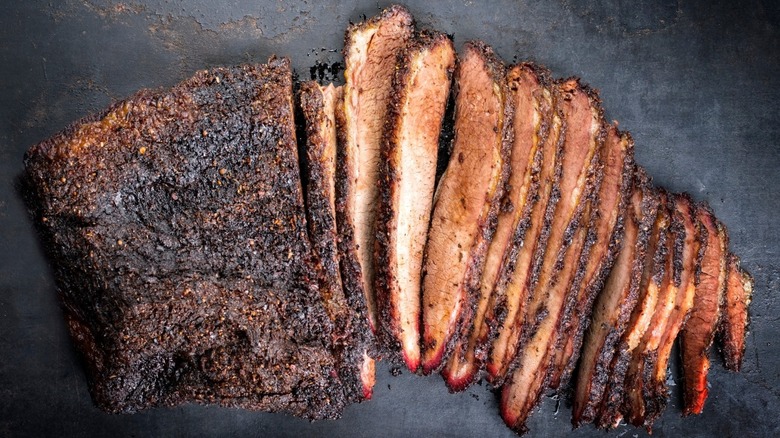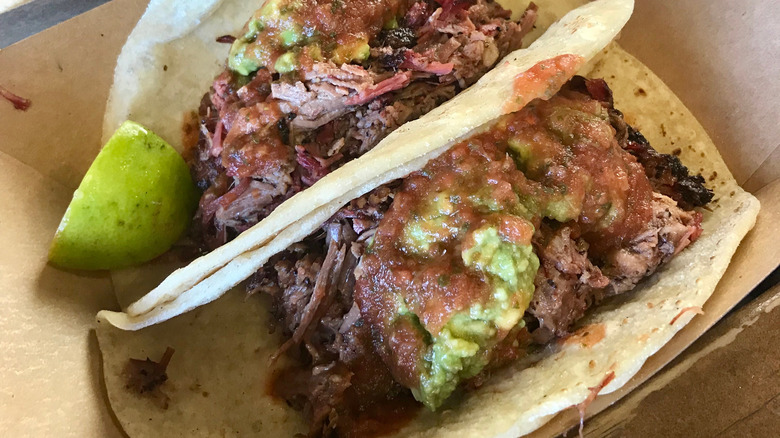The Origins Of Eating Brisket During Hanukkah
While the goyish world may associate the winter holidays with chestnuts roasting on an open fire and visions of dancing sugarplums, whatever those may be, Jewish families have a different set of food traditions. These include latkes and sufganiyot for Hanukkah, Chinese food for Christmas, and brisket for any time the whole mishpocha gets together for dinner. While brisket is not a Hanukkah-specific food, as Noah Bernamoff of Mile End Delicatessen once told Jewish news outlet The Forward, "Name any Jewish holiday and people will tell you they ate brisket."
So why is brisket a fixture of any and all Jewish holidays (Hanukkah included) in the same way that turkey is at Thanksgiving or ham at Eastertime? Brisket isn't a strictly Jewish holiday dish in and of itself, after all. This cut of meat is well-known in different Asian and European cuisines, as well, and Chipotle has been known to use brisket in its burritos (even if it did turn out to be one of the chain's biggest flops). Still, there are several reasons brisket is a classic Jewish comfort food that's particularly well-suited for large gatherings, and these seem to have roots as far back as the 19th century when Jewish immigrants brought their age-old traditions to the New World.
Brisket is potentially kosher and economical, to boot
One reason brisket became so popular in Jewish cooking is that it is, or can be, kosher, which is not something that can be said about every kind of beef. Only meat from the front part of the cow can qualify for kosher certification, but brisket comes from a cow's sternum area so it makes the cut (so to speak).
Another reason why brisket first caught on with early Jewish immigrants is that it was fairly cheap due to being a large, often tough cut of meat that needed to be cooked low and slow. In fact, the Ashkenazi butchers who settled in Texas first started smoking their brisket as a way to preserve this hard-to-sell meat until they could find any customers who were willing to buy the stuff. Still, it's not just brisket's budget-friendliness that makes it such a slam-dunk for large gatherings. There's also the fact that this cut of meat is not only big and cheap, but just needs to be tossed into a pot and braised all day long. Anything so low-effort sounds tailor-made for a holiday meal.
Best of all, ir's also versatile
One more reason for brisket's enduring popularity may be the fact that it can be customized to suit any bubbe. Some cooks braise their brisket in vinegar, others prefer tomato sauce, while still others go for soy sauce or soda. Nor does brisket need to be braised, either. Amarillo Askhenazis aren't the only ones smoking this meat — in fact, we have our own smoked brisket recipe, along with one for brisket spice rub. Plus we've got the classic oven-braised brisket covered, as well. Brisket can even be cooked in a sous-vide machine should your kitchen have such a pricey, single-purpose gadget.
The best part about cooking brisket, though, may be the leftovers since there are nearly as many recipes for these as there are for turkey or rotisserie chicken. Sure, you can always reheat your brisket in a variety of more or less complicated ways, but why would you go through the bother when it's more fun to turn it into something new? Leftover brisket can be used in sandwiches, salads, and stir-fries, or you could put it to use as a taco filling, in a casserole, or to stuff a batch of dumplings ... The list goes on, but we're going to cut to a public service announcement, instead. The USDA says the leftovers will only last up to four days in the fridge, although you may freeze the brisket (either unadorned or repurposed) for as long as you like.


